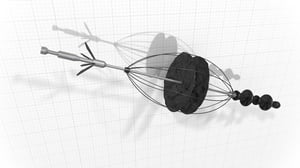
Is it possible to achieve success every time?
In the oil and gas industry, setting cement plugs is a critical operation with significant consequences for well integrity and performance.
However, without a firm support, the average failure rate for setting these plugs is alarmingly high, around 50%. This not only leads to increased operational costs but also risks compromising the entire well structure.
Since its introduction in 2002, the Cement Support Tool (CST) has transformed cement plug operations, providing a reliable solution that ensures the cement plug is set with confidence. By expanding to create a robust support base, the CST reduces the failure rate dramatically. With thousands of units deployed globally, the CST boasts a success rate of over 95%, making it a trusted choice for industry professionals.
Investing in the CST means choosing a proven, efficient, and cost-effective solution that enhances the reliability of your cementing operations. With its easy deployment, lack of need for additional tools or training, and versatility in various operational scenarios, the CST delivers unparalleled value, ensuring your cement plugs are set right the first time, every time.
How & Why does it work?
The CST is made of aluminum, fibre glass and strong fabrics, and prevent heavy cement slurry to swap place with well fluid below the cement plug. The CST is folded together like an unbrella when pumped through the drillpipe and tubing before it folds up when exiting the pipe. The CST can fill a hole sized 6" up to 42" depending on the CST model.
Browse the different CST model
The CST does not anchor to the wall or casing as it works as a floating piston in the fluid. There is no limitation to angle or depth. The CST has been used in hole depth >7,000 m (>23,000ft) and well angle up to 90deg from vertical. When using the CST the well must be static below the setting depth of the CST.
By choosing the CST, you invest in a proven solution that enhances the reliability, efficiency, and overall success of your cementing operations.
High Success Rate:
CST dramatically reduces the failure rate for setting cement plugs, boasting a success rate of over 95%.
Efficient and Reliable:
Designed for easy pumping through long work strings, CST ensures reliable support for off-bottom cement plugs, simplifying the cementing process.
Flexibility:
Available in five standard sizes and a customized version for coiled tubing, CST covers a wide range of needs in various operational scenarios.
No Extra Tools or Training Needed:
CST is easy to deploy without the need for additional tools or extensive training, making it cost-effective and user-friendly.
Versatility:
CST functions as a floating piston in the fluid, with no limitations on angle or depth, and has been used in hole depths greater than 7,000 meters and angles up to 90 degrees.
Quality Materials:
Made of aluminum, fiberglass, and strong fabrics, CST prevents heavy cement slurry from swapping places with well fluid below the cement plug.
Globally Proven:
With thousands of units deployed globally since 2002, CST is a trusted solution recognized by industry professionals worldwide.
Effective Plugging:
CST expands to create a robust support base, providing effective and reliable plugging in both open and cased holes.
Browse our Cement Support Tool models
The CST is available in five standard sizes, with an additional customized version specifically for coiled tubing. This variety ensures that you can select the perfect size for your specific cementing needs, maximizing the effectiveness and reliability of your operations.
Choosing the right CST size is straightforward and depends on two key factors:
-
The inner diameter of your work string
-
The inner diameter of the open or cased hole where the cement plug will be set
Cement Support Tool
BROWN MODEL
Work String Range 2 - 4½" ID
Hole / Casing Size 6 – 16" ID
Cement Support Tool
BLUE MODEL
Work String Range 2 - 5” ID
Hole / Casing Size 7 - 16” ID
Cement Support Tool
GREEN MODEL
Work String Range 2 ½ - 5.16" ID
Hole / Casing Range 7 ½" – 20" ID
Cement Support Tool
ORANGE MODEL
Work String Range 2 ½"-6"
Hole / Casing Range 7 ½" – 20" ID
Cement Support Tool
BLACK MODEL
Work String Range 4" - 6.5" ID
Hole / Casing Range 8" - 42" ID
Cement Support Tool
YELLOW MODEL
Coil Tubing CST 2 ⅜"
Hole / Casing Range 4" - 16" ID
See how the CST works
Download product sheets for all cement support tool models
The selection of six models of the Cement Support Tool (CST), including a customized version for coiled tubing allows you to choose the perfect size for your specific well conditions, maximizing the tool's effectiveness and reliability.
Success Stories with Cement Support Tools (CST)
Well Cementation and Wellhead Removal Campaign (Rig Chase), with the use of CST.
Complete losses occurred when a major operator in the North Sea was drilling a 16” section below a 17” liner.
There had been severe losses when a major operator in the Gulf of Mexico was drilling a 20” section below a 16” casing.
A major operator in the North Sea successfully plugged and abandoned a well with 6 separate cement plugs.
A major operator deployed a Cement Support Tool (CST) in a 82° well @ 4205m to use it as a base for a kick-off plug.

“The Cement Support Tool has become essential for our operations. Its ease of use and high success rate in cement plug operations have significantly improved our operational efficiency and productivity. We’ve cut our cementing time by nearly half.”
bridge plug for our plugs, saving time by not having to scrape and make up the BHA to set our base.”
faster and more reliable. We’ve managed to cut down our cementing time by 35%, which has been a huge benefit.”
available if we require it.”




